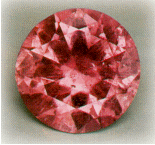Samson
Jewellery - Birth Stone
October / Pink Tourmaline
Tourmaline, a gem not widely known to gem buyers, displays the most dazzling and surpassing variety of colors of all known gemstones. Some crystals may display two or three color bands along their length, or show complex concentric zoning in cross section. Some o fthe most delicate, subtle, and exquisite colors in the mineral kingdom belong to the tourmaline group.
Tourmaline is actually a general group term that applies to several minerals with similar atomic structures and chemical compositions. Confusion sometimes arises because there are mineral species names (elbaite, schorl, and dravite) and names for color varieties: rubellite (pink and red), indicolite (blue), achroite (colorless), siberite (reddish-violet), and dravite (brown).
Tourmaline is available in the trade in large quantities and in a huge array of colors, yet it seems less well known than other gems. Tourmalines are hard and durable and make fine ringstones, especially when set with small diamonds. The price ranges from a few dollars per carat to more than $300 per carat, with large, flawless gems commanding the premium prices. Brazil produces most of the green and blue-green gems seen on the market, but occasional stones from other sources may be available to certain times and places.
Color determines price among tourmalines; the most desirable colors are a green resembling the color of fine emerald, characteristic of chrome-tourmaline, and lively pale-green shades, as well as the rich reddish-pink of fine rubellite. Flawed stones of any color are less desirable and less expensive than "clean" stones, except in the case of almost never completely free of inclusions or minor internal flaws.
Synthetic gems created to resemble tourmaline cannot be distinguished easily with the naked eye. Such synthetics are commonly found in jewelry today, since tourmaline is the alternate birthstone for October. The authenticity of a tourmaline should therefore always be checked before purchase.
